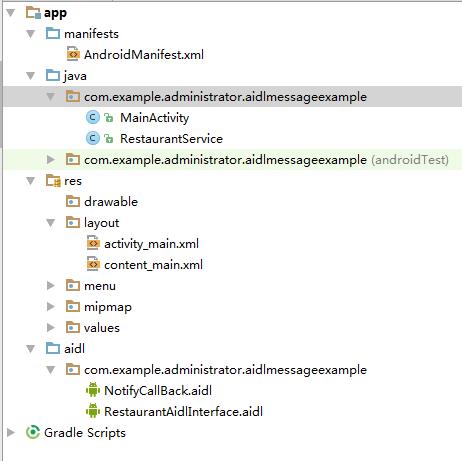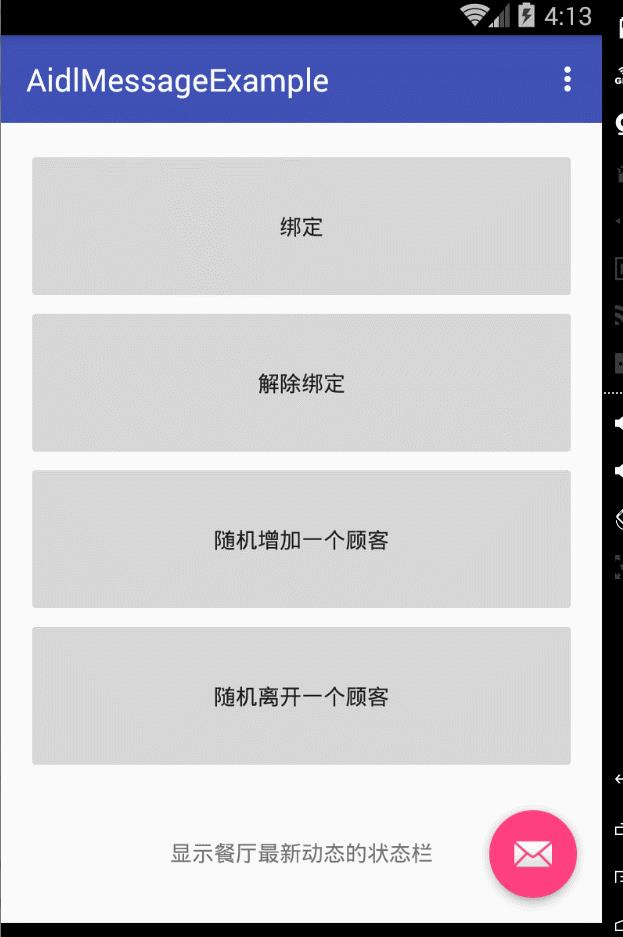Android AIDL SERVICE 双向通信 详解
Posted
tags:
篇首语:本文由小常识网(cha138.com)小编为大家整理,主要介绍了Android AIDL SERVICE 双向通信 详解相关的知识,希望对你有一定的参考价值。
http://www.cnblogs.com/punkisnotdead/p/5062631.html
起因 是这个blog 提到了 用webview 的时候 用开启子进程的方式 可以极大避免内存泄露。然后有很多人私信我 这种情况下
如何 相互通信的问题。当然广播是一个比较不错的选择,只不过广播的方法 能够传递的值比较有限。messenger 也只能做
单向传递消息。(当然你如果用2个 是可以双向的。单独的messenger是只能单向的)。
so,这里给出一个简单的小例子,教你如何处理 AIDL service双向通信的问题.
首先来建立一下这个例子的 模型,
1.我们假定有一个service 运行在 独立进程上,这个进程 就好像是餐厅一样。
2.我们的主进程呢,就好像是一个个顾客, 每次我们进入餐厅的时候 ,餐厅都会告诉我们 谁谁谁 进入了餐厅。
3.上述2条 我们注意看一下 餐厅的容量是有限的,所以我们的顾客进去以后吃完了就必须要出来。不然 餐厅的资源就有可能会被浪费 其他顾客就无法进入。
4.所以有一种场景是 当你的主进程也就是顾客 进入餐厅以后,万一你的主进程因为某种原因被杀死了,(比如退到后台的时候 内存不够 被kill掉)那你的service进程就必须要保证
把这个顾客移出掉,不然有限的资源 迟早会被耗尽,而且逻辑上也说不通。
下面就来实现这个需求。
首先看下 项目结构:

然后看一下我们的aidl文件:
1 // RestaurantAidlInterface.aidl 2 package com.example.administrator.aidlmessageexample; 3 import com.example.administrator.aidlmessageexample.NotifyCallBack; 4 // Declare any non-default types here with import statements 5 //这个就是aidl文件 6 interface RestaurantAidlInterface { 7 8 //新来了一个顾客 9 void join(IBinder token,String name); 10 //走了一个顾客 11 void leave(); 12 //注册回调接口 13 void registerCallBack(NotifyCallBack cb); 14 void unregisterCallBack(NotifyCallBack cb); 15 }
1 // NotifyCallBack.aidl 2 package com.example.administrator.aidlmessageexample; 3 4 // Declare any non-default types here with import statements 5 6 interface NotifyCallBack { 7 void notifyMainUiThread(String name,boolean joinOrLeave); 8 }
然后看看我们的service:
1 package com.example.administrator.aidlmessageexample; 2 3 import android.app.Service; 4 import android.content.Intent; 5 import android.os.IBinder; 6 import android.os.IBinder.DeathRecipient; 7 import android.os.RemoteCallbackList; 8 import android.os.RemoteException; 9 import android.support.annotation.Nullable; 10 11 import java.util.ArrayList; 12 import java.util.List; 13 import java.util.Random; 14 15 /** 16 * Created by Administrator on 2016/1/25. 17 */ 18 public class RestaurantService extends Service { 19 20 //这个list 就是用来存储当前餐厅有多少顾客 注意我们为什么没有用顾客的名字来存储? 21 //而是用了这个CustomerClient的类 看这个类的注释即可明白 22 private List<CustomerClient> mClientsList = new ArrayList<>(); 23 24 //上面用CustomerClient 的原因是因为害怕客户端异常销毁时,服务器收不到消息 造成资源浪费等异常 25 //同样的 我们在服务端通知客户端消息的时候 也害怕 服务端 会异常销毁 导致客户端收不到消息 26 //好在谷歌早就为我们考虑到这种情况 提供了RemoteCallbackList 来完成对应的功能 27 //避免我们再重复一遍上述的过程 28 private RemoteCallbackList<NotifyCallBack> mCallBacks = new RemoteCallbackList<>(); 29 30 31 private final RestaurantAidlInterface.Stub mBinder = new RestaurantAidlInterface.Stub() { 32 33 34 @Override 35 public void join(IBinder token, String name) throws RemoteException { 36 CustomerClient cl = new CustomerClient(token, name); 37 mClientsList.add(cl); 38 notifyCallBack(name, true); 39 } 40 41 @Override 42 public void leave() throws RemoteException { 43 //顾客离开的时候 我们随机让他离开一个就行了 44 int length = mClientsList.size(); 45 int randomIndex = new Random().nextInt(length-1); 46 mClientsList.remove(randomIndex); 47 notifyCallBack(mClientsList.get(randomIndex).mCustomerName, false); 48 } 49 50 @Override 51 public void registerCallBack(NotifyCallBack cb) throws RemoteException { 52 mCallBacks.register(cb); 53 } 54 55 @Override 56 public void unregisterCallBack(NotifyCallBack cb) throws RemoteException { 57 mCallBacks.unregister(cb); 58 } 59 }; 60 61 private void notifyCallBack(String customerName, boolean joinOrLeave) { 62 final int len = mCallBacks.beginBroadcast(); 63 for (int i = 0; i < len; i++) { 64 try { 65 // 通知回调 66 mCallBacks.getBroadcastItem(i).notifyMainUiThread(customerName, joinOrLeave); 67 } catch (RemoteException e) { 68 e.printStackTrace(); 69 } 70 } 71 mCallBacks.finishBroadcast(); 72 } 73 74 75 @Override 76 public void onDestroy() { 77 //销毁回调资源 否则要内存泄露 78 mCallBacks.kill(); 79 super.onDestroy(); 80 } 81 82 @Nullable 83 @Override 84 public IBinder onBind(Intent intent) { 85 return mBinder; 86 } 87 88 //http://developer.android.com/intl/zh-cn/reference/android/os/Binder.html#linkToDeath(android.os.IBinder.DeathRecipient, int) 89 //实际上 这个接口 就是用来 当客户端自己发生崩溃时, 我们的服务端也能收到这个崩溃的消息 90 //并且会调用binderDied 这个回调方法,所以你看这个内部类的代码 就明白了 无非就是保证当客户端异常销毁的时候 91 //我们服务端也要保证收到这个消息 然后做出相应的应对 92 final class CustomerClient implements DeathRecipient { 93 94 public final IBinder mToken; 95 96 public CustomerClient(IBinder mToken, String mCustomerName) { 97 this.mToken = mToken; 98 this.mCustomerName = mCustomerName; 99 } 100 101 public final String mCustomerName; 102 103 @Override 104 public void binderDied() { 105 //我们的应对方法就是当客户端 也就是顾客异常消失的时候 我们要把这个list里面 的对象也移出掉 106 if (mClientsList.indexOf(this) >= 0) { 107 mClientsList.remove(this); 108 } 109 110 } 111 } 112 }
1 <!-- 这个地方用开启子进程的方式来实现这个service 注意你们可以把主进程关闭以后 看看这个子进程 2 service list里面持有的那些对象能否收到 这个异常关闭的消息--> 3 <service 4 android:name=".RestaurantService" 5 android:enabled="true" 6 android:exported="true" 7 android:process="com.android.test.process"> 8 9 <intent-filter> 10 <action android:name="com.example.administrator.aidlmessageexample.RestaurantAidlInterface" /> 11 </intent-filter> 12 13 </service>
然后再看看 客户端 也就是主进程的编写:
1 package com.example.administrator.aidlmessageexample; 2 3 import android.content.ComponentName; 4 import android.content.DialogInterface; 5 import android.content.Intent; 6 import android.content.ServiceConnection; 7 import android.os.Binder; 8 import android.os.Bundle; 9 import android.os.IBinder; 10 import android.os.IInterface; 11 import android.os.Parcel; 12 import android.os.RemoteException; 13 import android.support.design.widget.FloatingActionButton; 14 import android.support.design.widget.Snackbar; 15 import android.support.v7.app.AppCompatActivity; 16 import android.support.v7.widget.Toolbar; 17 import android.view.View; 18 import android.view.Menu; 19 import android.view.MenuItem; 20 import android.widget.Button; 21 import android.widget.TextView; 22 import android.widget.Toast; 23 24 import org.w3c.dom.Text; 25 26 import java.io.FileDescriptor; 27 import java.util.Random; 28 29 public class MainActivity extends AppCompatActivity implements View.OnClickListener { 30 31 private Button bt, bt2, bt3, bt4; 32 33 private RestaurantAidlInterface mService; 34 35 private TextView tv; 36 37 38 private ServiceConnection mServiceConnection = new ServiceConnection() { 39 @Override 40 public void onServiceConnected(ComponentName name, IBinder service) { 41 mService = RestaurantAidlInterface.Stub.asInterface(service); 42 try { 43 //我们这个demo里面 只注册了一个回调 实际上可以注册很多个回调 因为service里面 我们存的是list callback 44 mService.registerCallBack(mNotifyCallBack); 45 } catch (RemoteException e) { 46 e.printStackTrace(); 47 } 48 49 } 50 51 @Override 52 public void onServiceDisconnected(ComponentName name) { 53 try { 54 mService.unregisterCallBack(mNotifyCallBack); 55 } catch (RemoteException e) { 56 e.printStackTrace(); 57 } 58 mService = null; 59 } 60 }; 61 62 63 private NotifyCallBack mNotifyCallBack = new NotifyCallBack.Stub() { 64 65 @Override 66 public void notifyMainUiThread(String name, boolean joinOrLeave) throws RemoteException { 67 String toastStr = ""; 68 if (joinOrLeave) { 69 toastStr = name + "进入了餐厅"; 70 } else { 71 toastStr = name + "离开了餐厅"; 72 } 73 tv.setText(toastStr); 74 } 75 }; 76 77 78 @Override 79 protected void onCreate(Bundle savedInstanceState) { 80 super.onCreate(savedInstanceState); 81 setContentView(R.layout.activity_main); 82 bt = (Button) this.findViewById(R.id.bt); 83 bt2 = (Button) this.findViewById(R.id.bt2); 84 bt3 = (Button) this.findViewById(R.id.bt3); 85 bt4 = (Button) this.findViewById(R.id.bt4); 86 tv = (TextView) this.findViewById(R.id.tv); 87 bt.setOnClickListener(this); 88 bt2.setOnClickListener(this); 89 bt3.setOnClickListener(this); 90 bt4.setOnClickListener(this); 91 92 Toolbar toolbar = (Toolbar) findViewById(R.id.toolbar); 93 setSupportActionBar(toolbar); 94 95 FloatingActionButton fab = (FloatingActionButton) findViewById(R.id.fab); 96 fab.setOnClickListener(new View.OnClickListener() { 97 @Override 98 public void onClick(View view) { 99 Snackbar.make(view, "Replace with your own action", Snackbar.LENGTH_LONG) 100 .setAction("Action", null).show(); 101 } 102 }); 103 } 104 105 @Override 106 public boolean onCreateOptionsMenu(Menu menu) { 107 // Inflate the menu; this adds items to the action bar if it is present. 108 getMenuInflater().inflate(R.menu.menu_main, menu); 109 return true; 110 } 111 112 @Override 113 public boolean onOptionsItemSelected(MenuItem item) { 114 // Handle action bar item clicks here. The action bar will 115 // automatically handle clicks on the Home/Up button, so long 116 // as you specify a parent activity in AndroidManifest.xml. 117 int id = item.getItemId(); 118 119 //noinspection SimplifiableIfStatement 120 if (id == R.id.action_settings) { 121 return true; 122 } 123 124 return super.onOptionsItemSelected(item); 125 } 126 127 @Override 128 public void onClick(View v) { 129 switch (v.getId()) { 130 case R.id.bt: 131 bindService(); 132 break; 133 case R.id.bt2: 134 unbindService(); 135 break; 136 case R.id.bt3: 137 addCustomer(); 138 break; 139 case R.id.bt4: 140 leaveCustomer(); 141 break; 142 } 143 144 } 145 146 private void bindService() { 147 Intent intent = new Intent(RestaurantAidlInterface.class.getName()); 148 bindService(intent, mServiceConnection, BIND_AUTO_CREATE); 149 } 150 151 private void unbindService() { 152 unbindService(mServiceConnection); 153 } 154 155 private void leaveCustomer() { 156 try { 157 // mService.registerCallBack(mNotifyCallBack); 158 mService.leave(); 159 } catch (RemoteException e) { 160 e.printStackTrace(); 161 } 162 } 163 164 private void addCustomer() { 165 try { 166 mService.join(new Binder(), getRandomString(6)); 167 } catch (RemoteException e) { 168 e.printStackTrace(); 169 } 170 } 171 172 public static String getRandomString(int length) { //length表示生成字符串的长度 173 String base = "abcdefghijklmnopqrstuvwxyz0123456789"; 174 Random random = new Random(); 175 StringBuffer sb = new StringBuffer(); 176 for (int i = 0; i < length; i++) { 177 int number = random.nextInt(base.length()); 178 sb.append(base.charAt(number)); 179 } 180 return sb.toString(); 181 } 182 }
最后跑一下效果(客户端进程异常结束 服务端进程收到消息 无法演示在gif里面,你们可以回去自己演示 看log日志 即可。直接用adb shell 命令 结束客户端进程 就行了)

以上是关于Android AIDL SERVICE 双向通信 详解的主要内容,如果未能解决你的问题,请参考以下文章